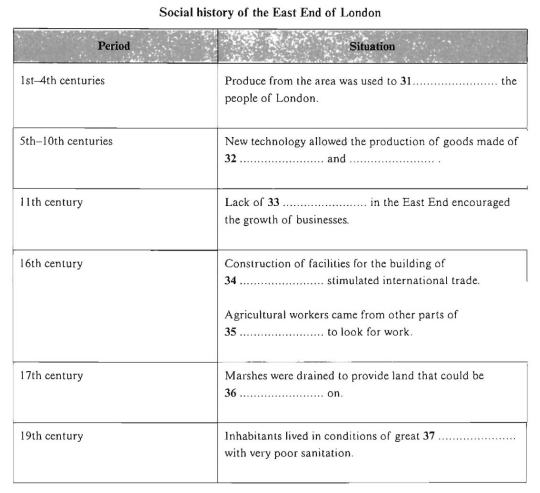剑桥雅思6:Test1雅思听力SECTION 4原文+真题+答案
发布时间:2020-09-09 关键词:为了帮助大家在雅思考试中取得的成绩,下面新航道小编为大家整理出关于剑桥雅思6:Test1雅思听力SECTION 4原文+真题+答案,大家可以多加练习。
原文:
In the last few weeks, we've been looking at various aspects of the social history of London, and this morning we're continuing with a look at life in the area called the East End. I'll startwith a brief history of the district, and then focus on life in the first half of the twentieth century, Back in the frst to the fourth centuries AD, when the Romans controlled England, Londongrew into a town of 45,00 people, and what's now the East End - the area by the riverThames, and along the road heading north-east from London to the coast - consisted offarmland with crops and livestock which helped to feed that population. The Romans left in 410, at the beginning of the fifth century. and from then onwards the country suffered a series of invasions by tribes from presenl-day Germaoy and Denmark,the Angles, Saxons and Jutes, many of whom settled in the East End. The technology they introduced meant thal metal and leather goods were produced there for the frst time. Aodas Q31the East End was by the river, ships could transport goods between there and foreign markets.
介绍意味着Thal金属和皮革制品是时间在那里生产的。奥达斯Q31东端在河边,船只可以在那里和国外之间运输货物。在过去的几个星期里,我们一直在研究伦敦社会历史的各个方面,今天早上我们将继续关注东端地区的生活。我将首先简要介绍这一地区的历史,然后集中讨论二十世纪上半叶的生活。 世纪,追溯到公元4世纪,当时罗马人控制了英格兰,伦敦发展成了一个拥有4500人的小镇,现在的东端--泰晤士河边的地区,沿着从伦敦向东北方向向东延伸到海岸的道路--由庄稼和牲畜组成,这些作物和牲畜帮助养活了这些人口。罗马人于410年离开,当时是五世纪初。从那时起遭受了一系列部落的入侵,这些部落来自前一天的Germaoy和丹麦,盎格鲁人,撒克逊人和朱特人,他们中的许多人定居在东端。他们的技术市场。
In the eleventh century, in 1066 to be precise, the Normans conquered England, and duringthe nexl few centurics London became one of the most powerful and prosperous cities in Europe. The East End benefiled from this, and because there were fewer resurictions there than in the city itself, plenty of newcomers settled there from abroad, bringing their skillsas workers, merchants or money-lenders during the next few hundred years.
在11世纪,准确地说是在1066年,诺曼人征服了英国,在这几个世纪中,伦敦成为最强大和最繁荣的城市之一。欧洲。东端从中受益,因为那里的复出事件较少。与城市本身相比,许多新移民从国外来到这里,在接下来的几百年里,他们带来了熟练的工人、商人或放债人。
In the sixteenth century the first dock was dug where ships were construcled, eventually making the East End the focus of massive international trade. And in the late sixteenth century, when much of the rest of England was sulTering economically. a lot of agricultural Q35workers came to the East End to look for alternative work.In the seventeenth century, the East End was still a series of separate, semi-rural settlements. There was a shortage of accommodation, so marshland was drained and bwilt on to house Q36the large numbers of people now living there. By the nincteenth century London was the busiest port in the world, and this became the main source of employment in the East End. Those who could afford to live in more pleasantsurroundings moved out, and the area became one where the vast majority of people livedin extreme poverty, and sufTered from appalling sanitary conditions.
十六世纪,座船坞被挖出来,最终建造了船只。使东区成为大规模国际贸易的焦点。在十六年末在这个世纪里,英国其他地方的大部分地区都在经济上闷闷不乐。许多农业Q35工人来到东区寻找替代工作。17世纪,东区仍然是一系列独立的半乡村聚落.由于住房短缺,沼泽地被排干了,于是就在Q36号的房子里,住着大量的人。到十九世纪,伦敦已成为世界上最繁忙的港口,成为世界上最繁忙的港口。东区主要就业来源。那些能够负担得起在更舒适的环境中生活的人搬出去了,这个地区成为了绝大多数人生活在极端贫困之中的地区,远离了恶劣的卫生条件。
That brief outline takes us to the beginning of the twentieth century, and now we'll turn tohousing.At the beginning of the century, living conditions for the majority of working people in East London were very basic indeed. Houses were crowded closely together and usually veryQ38139/40badly bil, because there was no regulation. But the poor and needy were attracted by the possibility of work, and they had to be housed. It was the availability, rather than the condition, of the housing that was the major concern for lenants and landlords alike.
这个简短的纲要把我们带到了二十世纪初,现在我们要谈谈住房问题。本世纪初,东部大多数劳动人民的生活条件伦敦确实是基础的。房子挤得很紧,通常都是Q 38139/40,因为没有规定。但穷人和穷人被工作的可能性,他们必须被安置。这是可用性,而不是住房的状况,这是宽大者和房东共同关心的主要问题。
Few houses had cecricity at this time. so other sources of power were used. like coal for the fires which heated perhaps just one room. Of course, the smoke from these contributeda great deal to the air pollution for which London used to be famous.
A liny, damp unhealthy house like this might well be accupied by Iwo full families. possibly Q38139140including several children. grandparents. aunts and uncles.
在这个时候,很少有房子有疯狂。所以其他的能源也被使用了。像煤一样可能只是一个房间的火。当然,这些烟雾在很大程度上助长了伦敦曾经以空气污染而闻名的空气污染。像这样潮湿潮湿的房子很可能会被伊沃全家人买走。可能是Q38139140,包括几个孩子。祖父母。阿姨和叔叔。
Now, before I go on to health implications of this way of life, I'll say something about foodand nutrition.
现在,在我继续讨论这种生活方式对健康的影响之前,我要谈谈食物和营养。
SECTION 4 真题:
Questions 31- -40 .
Questions 31-37
Complete the table below.
Write NO MORE THAN TWO WORDS for each answer.

Questions 38- -40
Choose THREE leters, A-G.
Which THR EE of the following problems are mentioned in connection with 20th centuryhousing in the East End?
A.unsympathetic landlords
B.unclean water
C.heating problems
D.high rents
E.overcrowding
F.poor standards of buildingG houses catching fire
答案:
Section 4, Questions 31- -40
31、feed
32、IN EITHER OR DERmetal leather
33、restrictions
34、ships
35、England
36、built
37、poverty
38 -40 1N ANY ORDER
C、E、F





